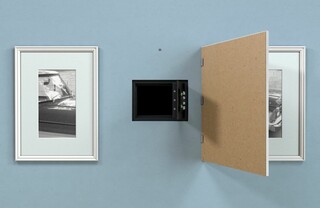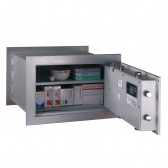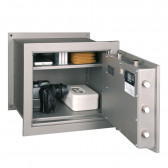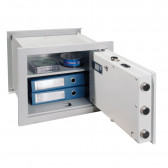Do you like the idea of anchoring a safe in the wall and hiding it behind a picture like in the movies? But do you wonder whether it's worth bothering with it at all? Or is it better to buy a free-standing safe? In this article we will dispel your doubts and show you where and how to install a built-in wall safe.
Is it worth investing in a built-in wall safe?
Nowadays everyone should have a safe at home. Thieves are not idle and keep a close eye on homes. Just a moment's inattention, an evening out with friends or a short trip – that's when you can fall prey to a robber.
Wall safes are just as safe as their free-standing counterparts, but they have several additional advantages. First of all, they don't take up any space in your home. They are very easy to hide behind a painting, mirror or portrait. The last most important advantage is that they cannot be carried away with their contents.
It's easy to customise a built-in safe to suit your needs. You can buy a small model to hold your most valuable possessions or invest in a larger one that will hold your valuables for many years. You can also fit a built-in safe in the floor, under the carpet or in the garage.
Fitting a built-in safe
A wall safe is best thought of before the house is built, but it can also be installed in a wall that has already been built. You can build it in a partition wall as well as in a load-bearing wall. The only limitation is the thickness of the wall. However, you can always add another strip of bricks to make the wall thicker.
The first step when installing a wall safe is to cut a hole in the wall. This must be larger and deeper than the safe itself. All this is done so that the armoured box is additionally protected with a layer of concrete on all sides.
The front of the built-in safe must be secured so as not to damage the lock, hinges and bolts. After concreting the safe into the wall, it is necessary to wait a few days for the mortar to dry. The cement may additionally be reinforced with metal mesh to strengthen the walls of the safe.
What can you store in a wall safe?
You can store anything of value in a built-in safe. You are only limited by its capacity, so it makes sense to choose larger models.
In a wall safe you can easily store items such as:
- ● money,
- ● jewellery,
- ● antiques,
- ● works of art,
- ● a stamp or coin collection,
- ● weapons and ammunition,
- ● documents.
You personalise the wall safe to meet your requirements. Choose the right shape, additional shelves or storage compartments. You can order a safe with a key lock or an electronic lock with a numerical dial. The built-in safe can be secured with additional vertical and lateral locks in the door.
The built-in safe can be secured with additional vertical and lateral locks located in the door. Armoured safes have reinforced hinges and a plate to protect the lock from being drilled through.
Which security class of a wall safe should I choose?
The security classes of safes are defined by international standards. Each must have a certificate confirming the level of burglary resistance.
The lowest security classes according to EN 14450 are:
● S1 (lower class),
● S2.
Wall safes made in accordance with EN 1143-1 and EN 1143-2 offer better protection. We recommend the purchase of a Class I safe made in accordance with these standards.
Each class has a specific maximum value of items or cash that you can keep in your safe. For example, in an S1 safe you can keep items with a value of up to approximately 60,000 zł. In a Class I safe, this value rises to around 600 000 PLN. Before buying, ask about the class of your built-in safe and find out how valuable your valuables are.
Locks for safes also have their own security levels. According to the EN 1300 standard, there are three different classes:
● A (lowest),
● B,
● C.
If I don't want a wall safe, what other choice do I have?
Remember that other types of safe are just as safe as built-in safes. Freestanding armoured safes can be firmly attached to the wall and floor. You don't have to limit yourself. If you don't want to damage your walls and make a mess in your home, choose another model.
You should be interested in, among other things:
- ● small safes for the home,
- ● gun safes,
- ● armoured glass cabinets for displaying valuables,
- ● safes for the office,
- ● floor safes.
Whichever safe you choose, it's sure to be a smart move. Armoured lockers will make you feel safer whether you're on holiday or enjoying a night out with friends. Remember to choose the security class according to the value of the items you are storing.
We also recommend to read: The most popular furniture safes





